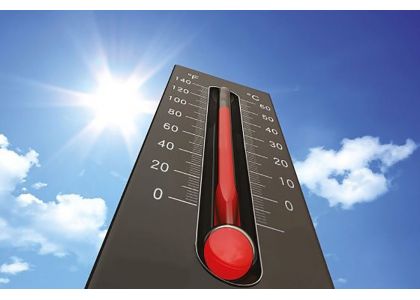
Feeling the stress? There are lots of different forms of stress in dairy production. Pathogenic, environmental, metabolic and transitional challenges are commonplace in dairy herds. Nutrition is the one thing these challenges have in common. The interaction between nutrition and the physiology of these production challenges is becoming clearer, and we are gaining know-how in the application of new understanding.
Summer months bring often unavoidable heat stress in some geographies, that affects both dairy and beef cattle. Dairy breeds are particularly susceptible to heat stress as they generate greater metabolic heat due to higher dry matter intakes (DMI).
Heat stress is often spotted by increased respiration rate which is also accompanied by a drop in DMI, contributing to reduced production. It is a multifactorial systematic problem and it is thought that, as well as reduced DMI, shifts in post absorptive glucose and lipid homeostasis may contribute to additional reductions in production.
It is a difficult one to tackle but thankfully there are a few nutritional approaches that can be taken to mitigate the impacts of heat stress.
Feeding behaviour is also impacted by heat stress. Dairy cattle will usually eat frequent but smaller meals and spend less time lying. In the rumen we see reduced rumination and altered VFA production with a decrease in the acetate to propionate ratio, possibly leading to negative impacts on milk fat production.
Manage forage inclusion: Fermentation of fibre in the rumen generates a lot of metabolic heat. During heat stress challenges, fibre can be reduced in the ration, but it is important that this is not done to the extent of causing a negative impact on the rumen. Keep an eye on the milk fat to protein ratio. A value below 1.2 indicates that there is not enough fibre in the diet, a reduced acetate production and therefore negative impacts on milk fat production and possibly signs of acidosis.
Meet the energy requirement: The additional energy requirement for a 650 kg dairy cow at 35°C vs 15°C producing 36 kg of milk is in the region of 22%. That energy gap can be hard to meet particularly as the cow also has a reduced intake. Feeding an energy dense rumen protected fat allows the nutritionist to increase energy density of the ration without impacting rumen fermentation.
Don’t forget about protein: Rumen function is not optimal during heat stress. As a result, microbial protein synthesis will also be impacted. Rumen protected protein sources can be fed to increase contribution of bypass to total metabolizable protein and help to ensure protein requirements are being met.
Watch out for acidosis: A limited DMI gives the temptation to increase rapidly fermentable carbohydrates. This will work in the short term but in the long term, it can easily lead to acidosis if not managed correctly. Consider using a buffer, pre or probiotic additive to manage rumen conditions and avoid negative impacts on the fibre fermenting bacteria.
Heat stress is a challenge that is here to stay and could also start to be a more common occurrence in parts of the world where it has previously not been.
The volatile markets of today only increase the pressure to keep control of ration costs and maximise the performance of dairy herds. However, heat stress is a challenge that is here to stay and could also start to be a more common occurrence in parts of the world where it has previously not been.
Management of heat stress will always be difficult, but nutrition has a very important role to play in mitigating losses in production and health. These nutritional approaches which, alongside other management practices such as housing ventilation, allow the nutritionist to be prepared to weather the challenge during the warmer months.